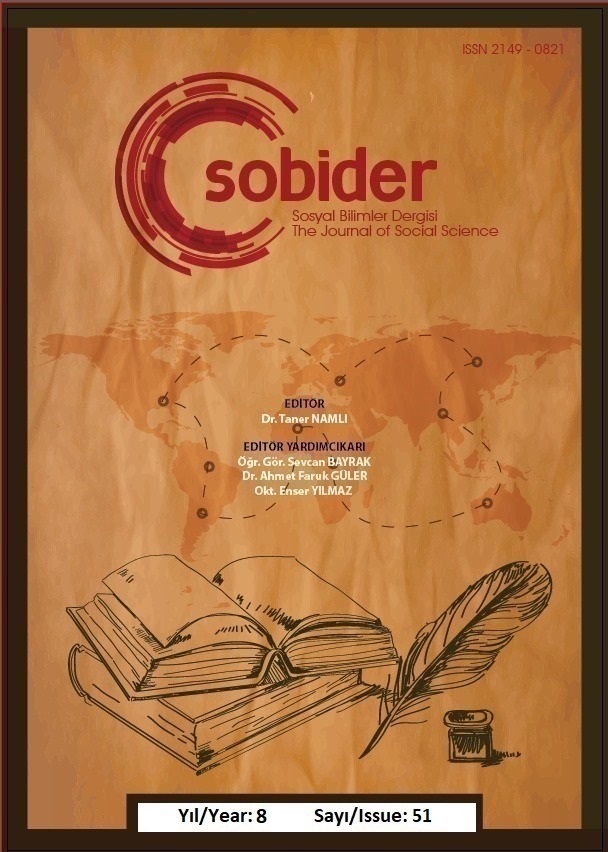Author :
Abstract
Mevsimler; dünyanın güneş etrafında bir yıl süren dönüşü sırasında, eksen eğikliğinin de etkisi ile dönemden döneme değişim gösteren hava koşulları ve doğa olaylarına verilen isimdir. Dünyanın güneş etrafındaki bu dönüş sırasında oluşan dört mevsim, üçer aylık bölümler ile birbiri peşine eklenerek döngüsel olarak devam eder. Bu döngüler içerisinde insanların yaşam şekillerinde, sosyal faaliyetlerinde, çalışma koşullarında mevsimden mevsime değişim gösteren farklıklar oluşur. 16. Yüzyıl Flaman resim sanatının öncülerinden olan Pieter Bruegel ’de “Mevsimler” konulu altı büyük panodan oluşan resim dizisinde, Erken Bahar, İlkbahar, Erken Yaz, Yaz Sonu, Sonbahar ve Kış dönemlerini, her biri diğerinin arkasından devam eden ikişer aylık süreçleri ele almıştır. “Kasvetli Gün”, “Saman Yapımcıları”, “Hasat”, “Sürünün Dönüşü” ve “Karda Avcılar” isimleri ile oluşturduğu bu dizide köy ve köylülerin mevsimlere göre açık havada gerçekleştirdikleri faaliyetler yine doğanın mevsimlere göre değişim gösteren görünümleri içerisinde resmedilmiştir. Bruegel’den önce de çeşitli konular bağlamında ele alınan “mevsimler” konusu; Ortaçağ dönemi el yazması eserlerde dini günler, tıp bilgileri ya da av konulu minyatürlerdeki sahnelerde, ayrıntıcı bir yaklaşımla yorumlanmıştır. 14., 15. ve 16. Yüzyıllarda saray, şato ve kilise gibi mimari yapıların duvarlarında yer alan fresk örneklerinde de “mevsim döngüleri” konusunun ikişer aylık zaman dilimleri halinde ele alınarak görselleştirildiği görülmektedir. Konu, olay örgüsü ve üslup açısından Bruegel’in resimleri ile ortak özellikler taşıyan bu resimler, onun mevsim döngülerini konu alan resimlerinin öncül kaynaklarını oluşturmaktadır.
Keywords
Abstract
Seasons; It is the name given to the weather conditions and natural events that change from period to period with the effect of the axial inclination during the rotation of the earth around the sun for a year. The four seasons that occur during this rotation of the earth around the sun continue cyclically, adding up one after the other in quarterly episodes. Within these cycles, differences occur in people's lifestyles, social activities, and working conditions, which vary from season to season. Pieter Bruegel, one of the pioneers of the 16th century Flemish painting, discussed the Early Spring, Spring, Early Summer, Late Summer, Autumn and Winter periods, each one following the other, in his painting series consisting of six large panels on "Seasons". . In this series created with the names of "The Gloomy Day", "Hay Makers", "Harvest", "The Return of the Herd" and "Hunters in the Snow", the activities of the villagers and villagers in the open air according to the seasons are depicted in the view of nature that changes according to the seasons. The subject of "seasons", which was discussed in the context of various issues before Bruegel; In medieval manuscripts, religious days, medical information or scenes in miniatures about hunting are interpreted with a detailed approach. In the examples of frescoes on the walls of architectural structures such as palaces, castles and churches in the 14th, 15th and 16th centuries, it is seen that the subject of "seasonal cycles" was handled and visualized in two-month periods. These paintings, which have common features with Bruegel's paintings in terms of subject, plot and style, constitute the primary sources of his paintings dealing with seasonal cycles.
Keywords
- Aydın, G. (2020). Pieter Brueghel’in Janr Resimlerinde Toplumun İzleri . Batman Üniversitesi Yaşam Bilimleri Dergisi , 151-162.
- Bourgoing, J. D. (2006). Takvim Zamanın Efendisi midir? İstanbul: Yapı Kredi Yayınları.
- Eco, U. (2020). Ortaçağ IV. Cilt. İstanbul : Alfa.
- Farthing, S. (2012). Sanatın Tüm Öyküsü. İstanbul: Hayalpereset Yayınevi.
- İpşiroğlu, M., & İpşiroğlu, N. (1977). Oluşum Sürecinde Sanatın Tarihi. İstanbul: Cem Yayınevi.
- Küpeli, B., & Şen, E. (2020). Evrensel Sokak Çocuk Oyunları: Pieter Buregel'in “Çocuk Oyunları” Eseri Üzerine. Ulakbilge Sosyal Bilimler Dergisi, 200-2013.
- https://gerryco23.wordpress.com/2015/07/03/in-pursuit-of-bruegel-the-holy-grail-in- vienna/#:~:text=Bruegel's%20depiction%20of%20the%20herd,pauses%20to%20savour %20wayside%20grass.
